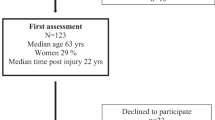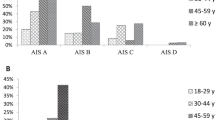Abstract
Study design:
Participants with spinal cord injury (SCI) sustained at least 15 years before the study completed questionnaires measuring posttraumatic growth (PTG), basic hope and coping strategies.
Objectives:
To determine contribution of basic hope and coping strategies to accounting for PTG variability in participants with traumatic long-term SCI.
Setting:
Polish rehabilitation centres, foundations and associations implementing social inclusion and professional activation programmes. Participants were enrolled based on their medical history by trained rehabilitation specialists and psychologists.
Methods:
The set of questionnaires included the following: The Post-traumatic Growth Inventory; The Coping Orientations to Problems Experienced (COPE); and Basic Hope Inventory.
Results:
A study of 169 individuals with paraplegia in the range of PTG showed the highest degree of positive changes in appreciation of life (AL) and the lowest in self-perception. Regression analysis showed that coping strategies such as religion (REL), focus on the problem, humour, alcohol/drug use ideation and basic hope jointly account for 60% of variance of PTG. The highest contribution to accounting for this variability had REL. Also, it was found that coping strategies and basic hope allow to predict variance of individual growth aspects. Age at trauma exposure positively correlated with changes in AL and spiritual change. No significant relationship between growth and age of participants was confirmed.
Conclusion:
PTG occurring in people with long-term traumatic SCI is primarily manifested in increased AL. Specific coping strategies and basic hope have a significant role in fostering positive changes.
Similar content being viewed by others

Log in or create a free account to read this content
Gain free access to this article, as well as selected content from this journal and more on nature.com
or
References
Pollard C, Kennedy P . A longitudinal analysis of emotional impact, coping strategies and post-traumatic psychological growth following spinal cord injury: a 10-year review. Br J Health Psychol 2007; 12: 347–362.
Chun S, Lee Y . The experience of posttraumatic growth for people with spinal cord injury. Qual Health Res 2008; 18: 877–890.
Kalpakjian CZ, McCullumsmith CB, Fann JR, Richards JS, Stoelb BL, Heinemann AW et al. Post-traumatic growth following spinal cord injury. J Spinal Cord Med 2014; 37: 218–225.
Tedeschi RG, Calhoun LG . Posttraumatic growth: conceptual foundations and empirical evidence. Psychol Inq 2004; 15: 1–8.
Trzebiński J, Zięba M . Basic hope as a world-view: an outline of a concept. Polish Psychol Bull 2004; 35: 173–182.
Zięba M, Czarnecka-van Luijken J, Wawrzyniak M . Nadzieja podstawowa i wzrost potraumatyczny [Basic hope and posttraumatic growth]. Studia Psychologiczne [Psychol Stud] 2010; 49: 109–121.
Livneh H, Martz E . Coping strategies and resources as predictors of psychosocial adaptation among people with spinal cord injury. Rehabil Psychol 2014; 59: 329–339.
Kennedy P, Lude P, Elfström ML, Smithson E . Cognitive appraisals, coping and quality of life outcomes: a multi-centre study of spinal cord injury rehabilitation. Spinal Cord 2010; 48: 762–769.
Chevalier Z, Kennedy P, Sherlock O . Spinal cord injury, coping and psychological adjustment: a literature review. Spinal Cord 2009; 47: 778–782.
Elfström ML, Ryden A, Kreuter M, Persson L-O, Sullivan M . Linkages between coping and psychological outcome in the spinal cord lesioned: development of SCL-related measures. Spinal Cord 2002; 40: 23–29.
Elfström ML, Kreuter M, Ryden A, Persson L-O, Sullivan M . Effects of coping on psychological outcome when controlling for background variables: a study of traumatically spinal cord lesioned persons. Spinal Cord 2002; 40: 408–415.
Kennedy P, Lude P, Elfström ML, Smithson E . Appraisals, coping and adjustment pre and post SCI rehabilitation: a 2-year follow-up study. Spinal Cord 2012; 50: 112–118.
Ogińska-Bulik N, Juczyński Z . Rozwój potraumatyczny—charakterystyka i pomiar. [Posttraumatic growth—characteristics and measurement]. Psychiatria [Psychiatry] 2010; 4: 129–142.
Wrześniewski K . Pomiar radzenia ze stresem—wybrane zagadnienia. [Measurement of coping with stress—selected issues]. Promocja Zdrowia. Nauki Społeczne i Medycyna [Health Promot Soc Sci Med] 1996; 8-9: 34–46.
Trzebiński J, Zięba M . Nadzieja, strata i rozwój. [Hope, loss and development]. Psychologia Jakości Życia [Psychol Qual Life] 2003; 1: 5–33.
Geber MM, Boals A, Schuettler D . The unique contributions of positive and negative religious coping to posttraumatic growth and PSD. Psycholog Relig Spirituality 2011; 3: 298–307.
McMillen JC, Cook CL. The positive by-products of spinal cord injury and their correlates. Rehabil Psychol 2003; 48: 77–85.
Zdankiewicz-Ścigała E. Nadzieja podstawowa jako moderator procesu adaptacji po traumie (Basic hope as a moderator of adaptation after trauma). In: Strelau J, Zawadzki B, Kaczmarek M (eds). Konsekwencje Psychiczne Traumy: Uwarunkowania i Terapia. (Psychological Sequelae of Trauma: Conditions and Therapy Wydawnictwo Naukowe Scholar: Warszawa, Poland, 2009, pp 128–149.
Parashar D . The trajectory of hope: pathways to find meaning and reconstructing the self after a spinal cord injury. Spinal Cord 2014; 53: 565–568.
Lohne V, Severinsson E . The power of hope: patients’ experiences of hope a year after acute spinal cord injury. J Clin Nurs 2006; 15: 315–323.
Chun S, Lee Y . The role of leisure in the experience of posttraumatic growth for people with spinal cord injury. J Leis Res 2010; 42: 393–415.
Kennedy P, Lude P, Elfström ML, Cox A . Perceptions of gain following spinal cord injury: a qualitative analysis. Top Spinal Cord Inj Rehabil 2013; 19: 202–210.
Author information
Authors and Affiliations
Corresponding author
Ethics declarations
Competing interests
The author declares no conflict of interest.
Rights and permissions
About this article
Cite this article
Byra, S. Posttraumatic growth in people with traumatic long-term spinal cord injury: predictive role of basic hope and coping. Spinal Cord 54, 478–482 (2016). https://doi.org/10.1038/sc.2015.177
Received:
Revised:
Accepted:
Published:
Issue date:
DOI: https://doi.org/10.1038/sc.2015.177


